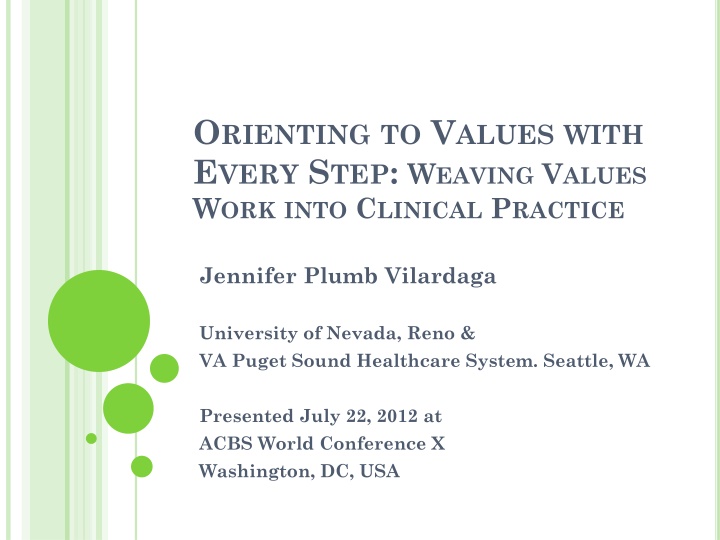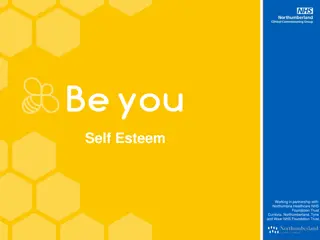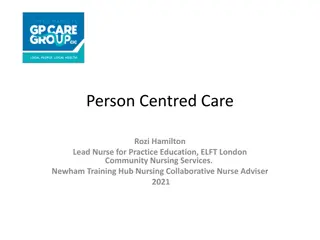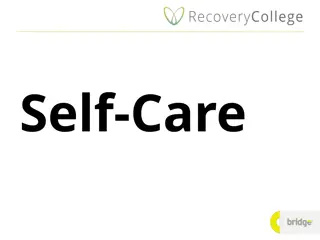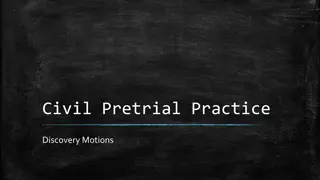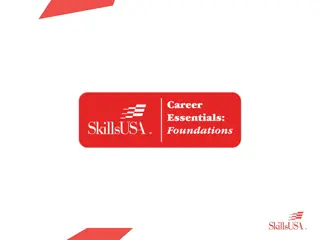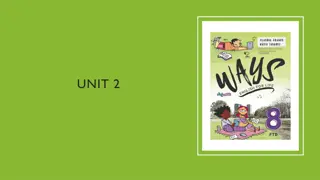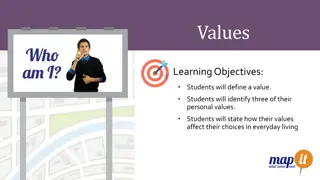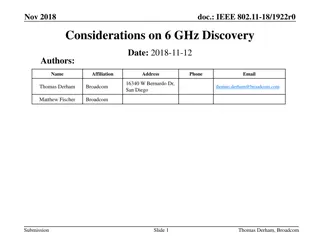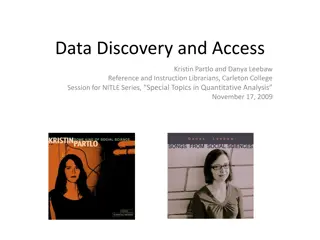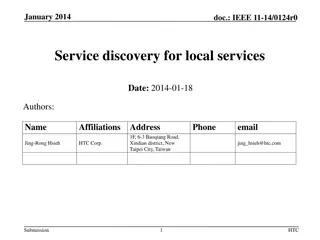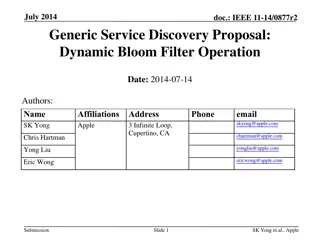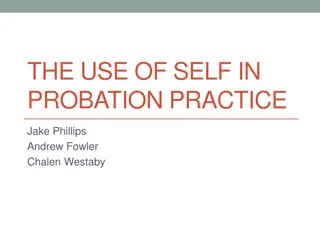Incorporating Values into Clinical Practice: A Journey of Self-Discovery
Explore the process of aligning personal values with professional roles in clinical practice through self-assessment, group work, and experiential exercises. Navigate the human condition's complexities to enhance therapeutic efficacy and foster personal growth in the context of challenging emotions and thoughts. Recognize the importance of expressing and articulating what truly matters in therapeutic interactions.
Download Presentation

Please find below an Image/Link to download the presentation.
The content on the website is provided AS IS for your information and personal use only. It may not be sold, licensed, or shared on other websites without obtaining consent from the author.If you encounter any issues during the download, it is possible that the publisher has removed the file from their server.
You are allowed to download the files provided on this website for personal or commercial use, subject to the condition that they are used lawfully. All files are the property of their respective owners.
The content on the website is provided AS IS for your information and personal use only. It may not be sold, licensed, or shared on other websites without obtaining consent from the author.
E N D
Presentation Transcript
ORIENTING TO VALUES WITH EVERY STEP: WEAVING VALUES WORK INTO CLINICAL PRACTICE Jennifer Plumb Vilardaga University of Nevada, Reno & VA Puget Sound Healthcare System. Seattle, WA Presented July 22, 2012 at ACBS World Conference X Washington, DC, USA
OUR VALUED PATH TODAY Overview Theory Practice Tools Values Self-Assessment Role-Play and Group Work Goal: Increase repertoire for talking about and expressing what matters
WHAT BRINGS US HERE Mattering Stuck points Individual Cases Topics Client Presentations Strengths to build on Brief introductions: Desires for today Setting in which you work/population(s) work with
VALUES SELF-ASSESSMENT: PART 1 Why did you choose to be a clinician? How has that changed since you first made that decision?
The Human Condition Lose contact with the present moment Lose contact with what we really want to be about in our lives Run away from hard thoughts and emotions Psychological Rigidity Settle into inaction, impulsivity, or avoidant persistence Get entangled with categorical, judgmental thought Buy into stories of who we are and what is possible for us see from one perspective
WHEN LIFEIS GOING WELL How do we know? Exercise Language can skew us to the negative Limited repertoire for talking about/expressing Appreciation Vitality Love (how many different kinds??) Caring Gratitude Need multiple exemplars to discriminate
VALUES SELF-ASSESSMENT: 2 What is one of your greatest strengths? As a therapist? As a friend? As a partner or family member? As (other important role)________________?
MOSTOF OUR CLIENTS Come to us when something isn t working in their lives Someone told them They are noticing Desire: make life better Burden vs. adventure
DEFINITIONOF VALUES Freely chosen Verbally constructed consequences Of ongoing, dynamic, evolving patterns of activity Which establishes predominant reinforcers for that activity That are intrinsic in engagement in the valued behavior pattern itself Wilson & DuFrene, 2009
OTHER IMPORTANT FEATURES Develop within a socioverbal context Therapy is a great one! Can never be completely attained Frustration vs. exploration Values as a direction, not the destination
OTHER IMPORTANT FEATURES Self-directed rules Help us choose behaviors that are likely to have particular consequences Motivative augmental rules Verbal relational networks alter the degree to which previously established consequences function as reinforcers or punishers I am grateful for my friends Heirarchical relational networks Extensive and complex Consequences may be abstract E.g., A just society
A LITTLE MORE THEORY RFT Pliance Wear your coat, it s cold outside Reinforcer (verbalized or perceived) comes from the social community for following the rule Tracking It s cold outside, I will wear a coat [been cold without a coat when it has been this temperature before] Reinforcer comes from the environment through engaging in the activity Rule is abstracted as a result of contacting the natural environment How would these show up in therapy?
PLIANT VALUING Examples with your clients? Examples with yourself?
VALUES SELF-ASSESSMENT 3 What client presentations /people are hardest for you to work with? What do you think may be underneath this for you? What might you be afraid of/unwilling to have/worried about happening? What client presentations /people are easiest for you to work with? What might be easy about this? (e.g., understanding, similar attitudes, shared experiences). What values do you think are similar?
MOSTOF US In Moments when we are walking our path . Present and Aware Listen Reflect Empathize Self-Compassionate Share Model Instigate Reinforce Others?
MOSTOF US In Moments when we are not walking our path . Entangled with thoughts Work too hard Reassure/Try to Take Away Pressure/Convince Orient toward private suffering Not self-compassionate Lose sight of our values Narrow focus on change from the Now And this isn t just with our clients .
THE LINKBETWEEN VALUESAND PAIN Values Vulnerability Fear of loss, failure, abandonment Thanks to language, we can experience that now
Loss Family Vitality LOVE Intimacy Rejection Physical Attraction Loneliness Tenderness
FUSIONAND AVOIDANCE Loss Vitality Family LOVE Intimacy Rejection Physical Attraction Loneliness Tenderness
ORIENTINGTO VALUES Loss Vitality Family LOVE Intimacy Rejection Physical Attraction Loneliness Tenderness
Two sides of the same coin In our values we find out pain, and in our pain we find our values Intimacy Loss
AND NOWA RADICAL IDEA Just like values and vulnerability co-exist . Human = Flawed AND (expanding relational network) Human = Whole, Complete, Perfect The You that Notices can notice both ORIENTING QUESTION: What do you want to be about in the Next Moment?
THERAPIST VALUES DECLARATION I will Honor your vitality and what is important to you; knowing that you may not be aware of these things See You beyond your story of yourself and your suffering; honoring your learning history Empathize with the tendency to get stuck with your stories and desire to solve the problem of your pain Appreciate the parts of you that know your vitality; and recognizing how scary living vitally can be, point out the human pull to avoid and move away from suffering that we both do Stand with you inside your suffering, compassionately recognizing your humanness, and support you taking small steps toward the things that matter most Reflect what it is like to see you embrace your pain and move in a conscious, vital and meaningful direction.
THERAPIST VALUES DECLARATION Be here, open up, do what matters I choose to Be Here with You, with all that entails, as you practice living your life with purpose
THERAPIST VALUES DECLARATION Create your own
TRACKING The how do we know question Attentional flexibility is KEY Therapeutic practice: building awareness of what works practicing talking about/expressing our reactions to what we notice that works & why Think of something you appreciate about someone you care about how often to do you tell or show them that?
TRACKING ~ THE MODEL Choosing to orient to the aspects of a situation, event, or experience that are in line with our values Different from positive thinking or reframing
TRACKING ~ THE MODEL Acting with Awareness Moving your feet, hands, mouth With awareness of Environment around us Our insides Helpful rules that if followed likely to move us toward things we care about, no matter what shows up Iterative process
TRACKING ~ THE MODEL As you do any other exercise in ACT, link it back to what matters to you or to the client: Mindfulness/Self-as-Context -- Showing Up: Helps you track what gets in the way as well as what happens around us Gotta look at someone to see them smiling
THE MODELWITHREGARDTO VALUES Acceptance -- Making Space For: You are more free to move in the direction of your choosing when you are not dragging difficult experiences behind you; when you pick them up, hold them and take them with you.
THE MODELWITH REGARDTO VALUES Examining Conceptualized Self -- Self-Stories: Tell you what is possible for your life or what you can handle, rather than you choosing that
THE MODELWITH REGARDTO VALUES Defusion -- Mindy Chatterbox: Useful or not and for what?
THE MODELWITHREGARDTO VALUES Committed Actions Behavioral Practice: Scary or outside comfort zone it is the whyin why on earth would you?
VALUES SELF-ASSESSMENT 4 What do you want to be about when it comes to your closest friends, family/partner, or being a parent? List one or two things you do that get in the way of you living consistent with these values. Share with neighbor
COMMON CLIENT PRESENTATIONS No Idea What I Care About Fix My Problem/Symptoms I m Broken/Changed/Undeserving Fused Values Fear of Failure or Getting Hurt Apparent Conflict between Values Others?
CLINICAL PRESENTATION: NO IDEA Past: Can you recall a time when you felt like life was going pretty OK? What was life like back then? What did you like the most? Heroes: Is there someone you look up to? What do you like about who they are or what they do? Aspects of self: What parts of yourself do you hate the least? What would [someone close to you] say [or would have said] are your best characteristics? Dreams: Something you have always wanted to do or try? Model for clients your dreams. Test Pilot: Try it on, best return policy on the planet
CLINICAL PRESENTATION: FIX IT What would they do if the problem were gone? Normalize, and really empathize with If I could, I would wave a magic wand. I d gladly do other work. This is the human condition everyone suffers in some way AND I am going to be here through the process with you What got you to try this [therapy] out? What makes coming here worthwhile? What keeps you coming? Hope as anchor Use their language Reflect in terms of your own therapist values Do not reassure
CLIENT PRESENTATION: FIX IT Entrenched As they are talking about the problem, listen for: Moments of less stickiness Exhaustion/fed up peace as a direction? Moments of levity ability to make fun of as form of defusion Opportunities to reinforce ANYTHING ELSE Example: Like everything else, I hate the food here. But I watch Giada on Food Network and the food tastes better to me. Be direct and compassionately shift the discussion, comment on why you are doing so Perhaps share YOUR value for being there and helping in particular way
CLINICAL PRESENTATION: BROKEN/UNDESERVING You are still here What did you care about before? If someone you loved was hurting, what would you want to do for them? How long would you be friends with someone who treats you as badly as your mind does? Therapist reflect the strengths you see Insightful/Great noticer Kind to others/giving/forgiving/complimentary Advocates for themselves or others
VALUES SELF-ASSESSMENT 5 How are your values for clinical work and your whole life the same or different?
CLIENT PRESENTATION: FUSED VALUES Fusion with life roles Threats to the self around what should be Fusion with evaluations about feelings Feelings are bad, I should feel good whenever I do something that matters Fusion with the concept of feelings as causes I wish I could do X, but I have to feel ready! Fusion with outcomes Intrinsic versus Extrinsic reinforcement
CLINICAL PRESENTATION: FUSED VALUES EXPRESSION Therapist sees ways that the client s values, while meaningful, seem to be highly fused in their expression E.g., client sates that they value honesty so much that they don t want to be around anyone that isn t radically honest back Compassionately look for workability Expand the conversation to include the intermediate reinforcers along the way Therapist reflects them for the client at first you are the socioverbal community If the client can show up to the process, does the ultimate outcome matter?
CLIENT PRESENTATION: FEAROF FAILURE Exercise: A time in your life Normalize this process Build repertoire for understanding what can get in our way Reiterate that choices are possible You can choose No now, Yes in next moment With choice comes responsibility; there may be unfortunate consequences Willingness is all or nothing, choose only from how high to jump Honor that clients may not be ready to choose to be willing Therapist: planting seeds for the future
EXAMINING WHATWE DOAND WHY Exploring the multiple reasons (sources of control) for our behavior. Avoiding something negative? Short-term outcome? What you think others want you to do? Meaningful living in the long run? Orient to meaningful living, but recognize that these others happen Examining things we do not enjoy in the moment, broadening the relational network to include what else that is about Changing diapers Taking out the trash does that change the function of the behavior? (and perhaps your experience in the moment?
CLIENT PRESENTATION: CONFLICTING VALUES Examine the nature of the conflict E.g., Religion vs. self; Family vs. self; Self vs. self Willingness Choosing one valued path may mean that it takes you away from other loved ones or other things you care about Help clients predict what might come up, allow them to make informed choices about all that comes from choosing one path versus another a place to directly practice the rest of the model Resolving the conflict is not the goal necessarily; exploring the process is an important skill What comes up for you as the therapist? Watch your own tendency to want to help them fix it judge one set of values as correct
